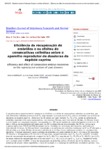Use este identificador para citar ou linkar para este item:
http://www.alice.cnptia.embrapa.br/alice/handle/doc/935002| Título: | Ação central do naloxone sobre as ß-endorfinas e hormônio luteinizante (LH) em ovelhas ovariectomizadas e hipoglicêmicas. |
| Autoria: | ELOY, A. M. X.  RODWAY, R.   |
| Afiliação: | ANGELA MARIA XAVIER ELOY, CNPC; Richard Rodway, Department of Animal Physiology and Nutrition, University of Leeds, Leeds - England. |
| Ano de publicação: | 1999 |
| Referência: | Brazilian Journal of Veterinary Research and Animal Science, São Paulo, v. 36, n. 5, p. 253-257, 1999. |
| Conteúdo: | Resumo: Com a finalidade de se investigar o efeito no Sistema Nervoso Central (SNC) do opióide antagonista naloxone hidrocloride sobre a liberação do hormônio luteinizante (LH) em ovelhas ovariectomizadas e hipoglicêmicas, utilizaram-se oito fêmeas mestiças oriundas das raças Mule e Suffolk, pesando 65,7 ± 3,6 kg. Duas semanas antes do início dos trabalhos, os animais foram canulados bilateralmente nos ventrículos. Foram feitos dois tratamentos (TI- animais não-estressados; TII- animais estressados), que foram subdivididos em três grupos (solução salina, 1 mg e 2 mg de naloxone). Os animais foram distribuídos, aleatoriamente, dentro das parcelas e foram feitas repetições com intervalo de uma semana, até que se alcançassem quatro observações por tratamento. No TI não se observou alteração nas concentrações de ß-endorfinas e LH, enquanto no TII, apesar de os animais não apresentarem alterações nos níveis de ß-endorfinas após injeção intracerebroventricular (i.c.v.) de 1 mg de naloxone, observou-se diminuição significativa (p<0,05) após injeção (i.c.v.) de 2 mg. No TII, as concentrações de LH aumentaram significativamente (p<0,05) após injeção (i.c.v.) de 1 e 2 mg de naloxone. Conclui-se, portanto, que mesmo na ausência dos esteróides gonadais, os opióides endógenos estão envolvidos no controle do LH em animais hipoglicêmicos. [Central action of the naloxone on ß-endorphins and luteinizing hormone (LH) in ovariectomized and hypoglicemic ewes]. Aiming to investigate the central effect of the opioid antagonist naloxone hydrochloride on the release of the luteinizing hormone (LH) and ß-endorphin in ovariectomized and hypoglycemic ewes, eight female (65.7 ± 3.6 kg), Mule x Suffolk cross, were used. Two weeks before the beginning of the experiment, the animals received guides directed towards to both sides of the lateral ventricle. There were two treatments (TI- non-stressed animals; TII- stressed animals), which were divided into three groups (saline solution, 1 mg and 2 mg of naloxone). The animals were randomly distributed and the experiments were repeated until getting four observations per treatment. It was not either observed significant alteration in the ß-endorphin concentrations or in the LH levels in the animals submitted to TI. The animals of the TII did not show significant alterations in the ß-endorphin levels after (i.c.v.) injection of 1 mg of naloxone, but showed a significant (p<0.05) decrease after naloxone injection (2 mg). The LH concentrations showed a significant (p<0.05) increase after naloxone injections in the TII. The results allow us to conclude that even in the absence of gonadal steroids, the endogenous opioids are involved in the control of the LH release in hypoglycemic animals. |
| Thesagro: | Ovino Ovelha Reprodução animal Hormônio Stress |
| NAL Thesaurus: | Sheep Naloxone Animal reproduction |
| Palavras-chave: | Naloxona Opióide Brasil LH Endogenous |
| Digital Object Identifier: | http://dx.doi.org/10.1590/S1413-95961999000500006 |
| Tipo do material: | Artigo de periódico |
| Acesso: | openAccess |
| Aparece nas coleções: | Artigo em periódico indexado (CNPC)  |
Arquivos associados a este item:
| Arquivo | Descrição | Tamanho | Formato | |
|---|---|---|---|---|
| CNPC1999Acao.pdf | 796.7 kB | Adobe PDF |  Visualizar/Abrir |









